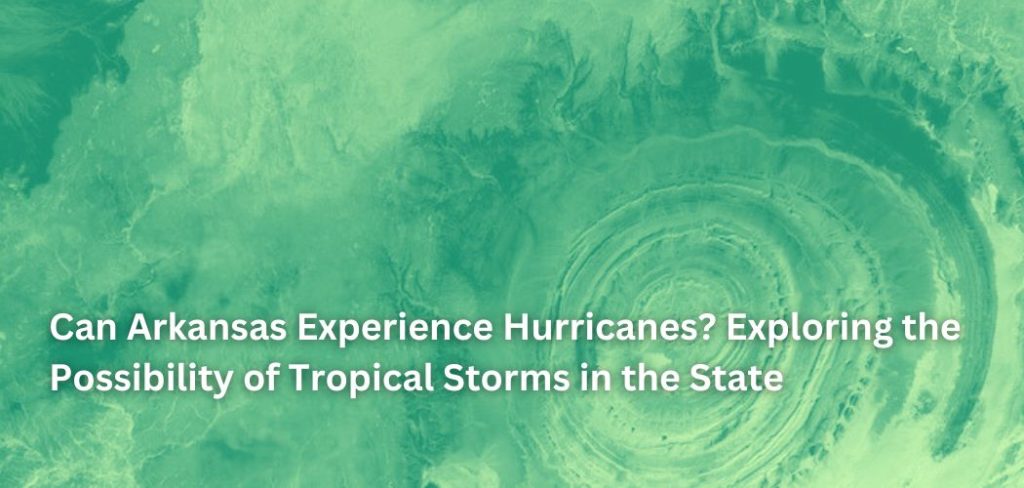Arkansas is known for its natural beauty, cultural heritage, and diverse wildlife.
However, being located in the southern United States, it is also susceptible to natural disasters such as hurricanes.
The state has experienced the effects of tropical storms and hurricanes in the past, but can Arkansas get hurricanes of its own?
Arkansas is not a coastal state, which means it is not directly on the path of hurricanes. However, the state is not immune to the effects of these storms.
Hurricanes can cause flooding, strong winds, and tornadoes, which can lead to significant damage to property and loss of life. While the state has not experienced a direct hit from a hurricane, it has been affected by the remnants of these storms.
Key Takeaways
- Although Arkansas is not a coastal state, it is still susceptible to the effects of hurricanes, such as flooding, strong winds, and tornadoes.
- Hurricanes are massive, rotating storms that form over warm waters in the Atlantic Ocean and Gulf of Mexico, and can cause significant damage due to their strong winds, storm surge, and heavy rainfall.
- While Arkansas has not experienced a direct hit from a hurricane, it has been affected by the remnants of these storms.
Arkansas and Hurricanes: An Overview
Arkansas is a state located in the southern region of the United States. It is known for its diverse geography, ranging from the Ozark and Ouachita Mountains to the Mississippi Delta. While Arkansas is not a coastal state, it is still susceptible to the effects of hurricanes due to its location and topography.
Hurricanes are tropical storms that form over warm ocean waters and can cause significant damage to coastal areas.
Arkansas is not directly in the path of most hurricanes, but it can still experience the effects of these storms, such as heavy rainfall, flooding, and strong winds.
According to the National Weather Service, Arkansas has been affected by several tropical systems in the past, including Hurricane Laura in 2020, which caused significant damage in the state.

While the frequency of hurricanes affecting Arkansas is relatively low compared to coastal states, the state is still at risk of experiencing the effects of these storms.
During hurricane season, which typically runs from June to November, it is important for Arkansas residents to stay informed about the weather and be prepared for any potential impacts from tropical storms.
This includes having a plan in place for evacuation or sheltering in place, as well as stocking up on necessary supplies such as food, water, and medication.
Overall, while Arkansas is not a coastal state, it is still important for residents to be aware of the potential impacts of hurricanes and take necessary precautions to stay safe during these storms.
Understanding Hurricanes
Arkansas is not a coastal state, and it is located over 220 miles from the nearest coastline. This geographic location makes it highly unlikely for the state to experience hurricanes. Hurricanes require warm waters to generate and sustain their strength, and they tend to break up over mountainous areas. This combination of conditions prevents hurricanes from occurring in Arkansas.
However, tropical storms and tropical cyclones are still possible in Arkansas. A tropical cyclone is a rotating, organized system of clouds and thunderstorms that originates over tropical or subtropical waters and has a closed low-level circulation. These storms are classified in terms of wind speed, with a tropical depression being a tropical cyclone with maximum sustained winds of 38 mph or less.
Tropical storms, on the other hand, have maximum sustained winds between 39 and 73 mph. They can cause significant damage, including flooding, power outages, and property damage. In the past, tropical storms have affected Arkansas, and their remnants have caused flooding and damage to the state.
It is essential to understand the terminology used when discussing hurricanes and tropical storms. The National Hurricane Center (NHC) is responsible for issuing forecasts and warnings for tropical storms and hurricanes. The NHC provides information on the storm’s location, intensity, and forecasted path. It is crucial to follow the NHC’s official forecast and beware of unreliable sources.
In conclusion, while Arkansas is not likely to experience hurricanes, tropical storms and tropical cyclones are still possible. It is essential to understand the terminology used when discussing these storms and to follow the NHC’s official forecast to stay informed and prepared.
Hurricane Impact on Arkansas
Arkansas is not a state that typically experiences hurricanes, but it is not immune to their effects. The state is located inland and is not directly on the coast, which makes it less likely to experience a direct hit from a hurricane. However, the state can still be impacted by hurricanes that make landfall along the Gulf Coast.
In 2005, Hurricane Katrina caused widespread damage and power outages in eastern Arkansas. The storm weakened significantly by the time it reached Arkansas, but it still caused significant damage. The storm knocked out power to thousands of homes and businesses, and it caused significant flooding in some areas.
In 2008, Hurricane Gustav caused power outages and some flooding in western Arkansas. The storm weakened significantly by the time it reached Arkansas, but it still caused significant damage.
In 2020, Hurricane Laura caused wind damage, tornadoes, and flooding in some parts of Arkansas. The storm weakened significantly by the time it reached Arkansas, but it still caused significant damage.
In 2021, Hurricane Ida brushed central Arkansas and brought scattered showers and tropical moisture to the area. The storm did not cause significant damage in the state.
The National Weather Service in Little Rock notes that Arkansas is affected by a landfalling North Atlantic tropical cyclone an average of four to five times in a given decade. However, it is important to note that not all of these storms will make landfall in Arkansas, and even those that do may weaken significantly before reaching the state.
Overall, while Arkansas is not directly in the path of most hurricanes, it can still be impacted by these storms. Residents should stay informed about the weather and be prepared for potential impacts from hurricanes that make landfall along the Gulf Coast.
Geographical Factors Influencing Hurricanes in Arkansas
Arkansas is not a coastal state and is relatively far from the Atlantic and Pacific Oceans. However, it is still possible for Arkansas to be affected by hurricanes due to its location and other geographical factors.
The state of Arkansas is located in the southern region of the United States and is bordered by several coastal states, including Louisiana, Mississippi, and Texas. The Gulf of Mexico, which is known for producing powerful hurricanes, is also located to the south of Arkansas. These factors make Arkansas vulnerable to hurricanes that form in the Gulf of Mexico and move inland.

While hurricanes are not as common in Arkansas as they are in other coastal states like Florida or North Carolina, they can still occur. In fact, Arkansas has been affected by several hurricanes in the past, including Hurricane Laura in 2020 and Hurricane Ida in 2021.
Another factor that can influence the occurrence of hurricanes in Arkansas is tornado alley. This region is known for producing tornadoes, but it can also be a pathway for hurricanes that move inland from the Gulf of Mexico. When hurricanes move inland, they can produce heavy rainfall, strong winds, and even tornadoes.
In summary, while hurricanes are not as common in Arkansas as they are in other coastal states, the state is still vulnerable to these powerful storms. Its location near the Gulf of Mexico and other coastal states, as well as its proximity to tornado alley, make it possible for hurricanes to affect Arkansas.
Seasonal Trends and Hurricanes
Arkansas is not typically known for being directly impacted by hurricanes, but it can still be affected by the seasonal trends of these storms. The Atlantic hurricane season runs from June 1st to November 30th, with the peak season occurring between mid-August and late October. During this time, the likelihood of hurricanes and tropical storms increases, and Arkansas can experience indirect impacts such as heavy rainfall and flooding.
In September and November, the risk of hurricane impacts on Arkansas decreases as the season begins to wind down. However, it’s important to note that tropical systems can still form outside of the official hurricane season. In fact, the National Hurricane Center has recorded tropical storms forming in every month of the year except for April.
During the peak season, it’s important for residents of Arkansas to stay informed and prepared for potential impacts. The National Oceanic and Atmospheric Administration (NOAA) predicts that the 2023 Atlantic hurricane season will be busy, with a 60% chance of an above-normal season. It’s important to note that while the number of storms predicted can be an indicator of the season’s activity, it only takes one storm to cause significant damage.
In the winter months, the risk of hurricanes and tropical storms impacting Arkansas decreases significantly. However, it’s still important to be aware of the potential for storms to form outside of the official season. It’s also a good time to review emergency plans and prepare for the upcoming hurricane season.
Overall, while Arkansas may not be directly impacted by hurricanes, it’s still important to stay informed and prepared for potential indirect impacts such as heavy rainfall and flooding. By staying aware of seasonal trends and taking appropriate precautions, residents can mitigate the potential impacts of these storms.
Storm Characteristics and Their Effects
Being located inland, Arkansas does not typically experience hurricanes. However, the state can still be affected by tropical systems, including tropical depressions and remnants of hurricanes. These systems can bring heavy rainfall, flooding, and strong winds to the state.
Decaying tropical systems have a history of producing a number of potential hazards in Arkansas, including tornadoes, wind damage, heavy rains, and associated flash flooding, as well as devastating river flooding. Southeastern and eastern Arkansas along the Mississippi River can be particularly vulnerable to these hazards.
The path of a tropical system can greatly impact the amount of rainfall and flooding experienced in Arkansas. If a storm moves slowly or stalls over the state, it can produce significant rainfall and lead to flooding. Additionally, tropical moisture can enhance rainfall from other weather systems, such as cold fronts, and lead to flooding.
Strong winds and wind gusts are also a concern with tropical systems. While Arkansas does not typically experience hurricane-force winds, tropical systems can still bring gusts strong enough to cause damage to trees and power lines.
Storm surge, a rise in sea level caused by a hurricane’s winds and low pressure, is not a concern for Arkansas due to its inland location. However, flash flooding and river flooding can still cause significant damage and should not be underestimated.
In summary, while Arkansas does not typically experience hurricanes, the state can still be affected by tropical systems and their remnants. These systems can bring heavy rainfall, flooding, and strong winds, which can lead to hazards such as tornadoes, wind damage, and flash flooding. It is important to stay informed about weather conditions and take necessary precautions to stay safe during these events.
Tracking and Updates on Hurricanes
Arkansas is not typically considered a state that is at high risk for hurricanes. However, it is still possible for the state to be affected by tropical storms and hurricanes, especially during the Atlantic hurricane season which runs from June 1 to November 30.
When a hurricane or tropical storm is approaching, it is important to stay up-to-date with the latest tracking and updates. The National Weather Service (NWS) is responsible for issuing watches and warnings for hurricanes and tropical storms in the United States. They use a variety of tools, including radar and satellite imagery, to track storms and provide updates on their location, intensity, and potential impacts.
In the past, some hurricanes have impacted Arkansas, such as Hurricane Elena in 1985. While it was downgraded to a tropical storm by the time it reached Arkansas, it still caused significant damage and flooding in the state. Additionally, Hurricane Katrina in 2005 caused heavy rainfall and flooding in parts of Arkansas.

It is also worth noting that hurricanes can weaken as they move inland, but they can still bring heavy rainfall and strong winds that can cause damage and flooding. In some cases, the remnants of a hurricane can still cause significant impacts even after it has weakened.
Overall, while Arkansas may not be at high risk for hurricanes, it is still important to stay informed and prepared during hurricane season. The NWS and other weather organizations provide regular updates and tracking information to help keep people safe and informed.
